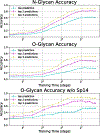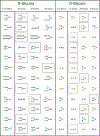Boltzmann Model Predicts Glycan Structures from Lectin Binding
- PMID: 38720429
- PMCID: PMC11162346
- DOI: 10.1021/acs.analchem.3c04992
Boltzmann Model Predicts Glycan Structures from Lectin Binding
Abstract
Glycans are complex oligosaccharides that are involved in many diseases and biological processes. Unfortunately, current methods for determining glycan composition and structure (glycan sequencing) are laborious and require a high level of expertise. Here, we assess the feasibility of sequencing glycans based on their lectin binding fingerprints. By training a Boltzmann model on lectin binding data, we predict the approximate structures of 88 ± 7% of N-glycans and 87 ± 13% of O-glycans in our test set. We show that our model generalizes well to the pharmaceutically relevant case of Chinese hamster ovary (CHO) cell glycans. We also analyze the motif specificity of a wide array of lectins and identify the most and least predictive lectins and glycan features. These results could help streamline glycoprotein research and be of use to anyone using lectins for glycobiology.
Conflict of interest statement
Conflict of interest disclosure
N.E.L. and A.W.T.C. have submitted patents associated with the use of lectin binding patterns for determining glycan structures and disease diagnostics. N.E.L. is also co-founder and holds financial interest in NeuImmune and Augment Biologics, which focus on glycoprotein therapeutics.
Figures










Update of
-
A Boltzmann model predicts glycan structures from lectin binding.bioRxiv [Preprint]. 2024 Mar 12:2023.06.03.543532. doi: 10.1101/2023.06.03.543532. bioRxiv. 2024. Update in: Anal Chem. 2024 May 28;96(21):8332-8341. doi: 10.1021/acs.analchem.3c04992. PMID: 37333412 Free PMC article. Updated. Preprint.
Similar articles
-
A Boltzmann model predicts glycan structures from lectin binding.bioRxiv [Preprint]. 2024 Mar 12:2023.06.03.543532. doi: 10.1101/2023.06.03.543532. bioRxiv. 2024. Update in: Anal Chem. 2024 May 28;96(21):8332-8341. doi: 10.1021/acs.analchem.3c04992. PMID: 37333412 Free PMC article. Updated. Preprint.
-
Application of lectin microarray to crude samples: differential glycan profiling of lec mutants.J Biochem. 2006 Mar;139(3):323-7. doi: 10.1093/jb/mvj070. J Biochem. 2006. PMID: 16567396
-
Cell surface lectin array: parameters affecting cell glycan signature.Glycoconj J. 2013 Apr;30(3):195-203. doi: 10.1007/s10719-012-9433-y. Epub 2012 Aug 17. Glycoconj J. 2013. PMID: 22899543
-
Lectin-resistant CHO glycosylation mutants.Methods Enzymol. 2006;416:159-82. doi: 10.1016/S0076-6879(06)16011-5. Methods Enzymol. 2006. PMID: 17113866 Review.
-
Lectins: Biological significance to biotechnological application.Carbohydr Res. 2021 Aug;506:108367. doi: 10.1016/j.carres.2021.108367. Epub 2021 Jun 8. Carbohydr Res. 2021. PMID: 34130214 Review.
Cited by
-
The future of plant lectinology: Advanced technologies and computational tools.BBA Adv. 2025 Jan 28;7:100145. doi: 10.1016/j.bbadva.2025.100145. eCollection 2025. BBA Adv. 2025. PMID: 39958819 Free PMC article.
-
LeGenD: determining N-glycoprofiles using an explainable AI-leveraged model with lectin profiling.bioRxiv [Preprint]. 2024 Mar 30:2024.03.27.587044. doi: 10.1101/2024.03.27.587044. bioRxiv. 2024. PMID: 38585977 Free PMC article. Preprint.
References
-
- Hennet T Diseases of glycosylation beyond classical congenital disorders of glycosylation. Biochimica et Biophysica Acta (BBA) - General Subjects 2012, 1820, 1306–1317, Glycoproteomics. - PubMed
MeSH terms
Substances
Grants and funding
LinkOut - more resources
Full Text Sources

